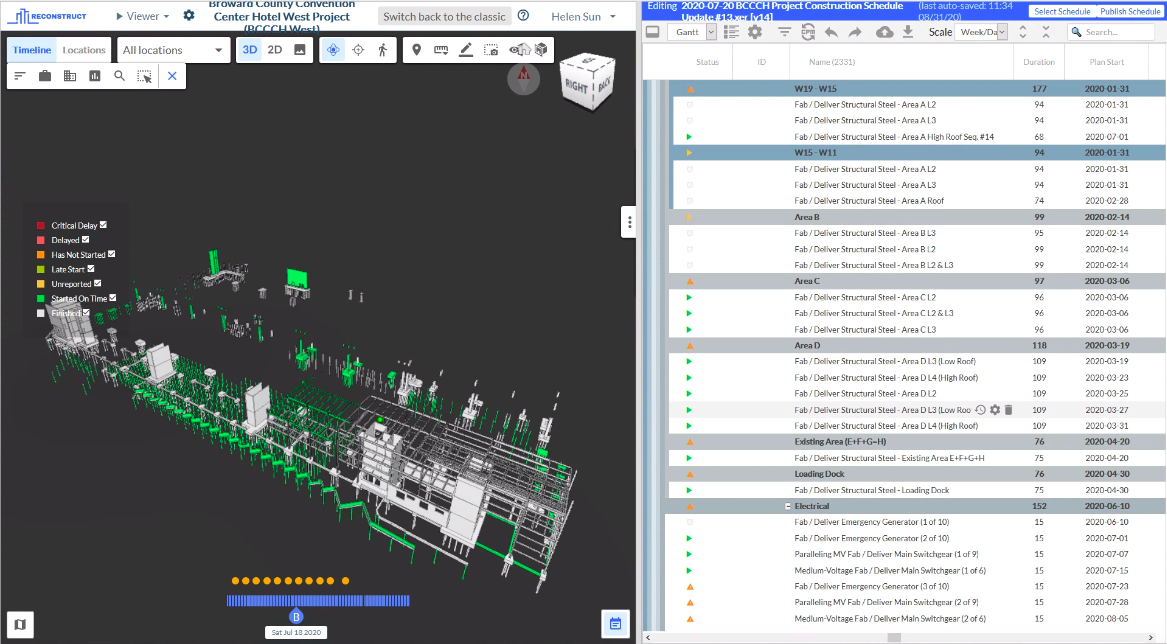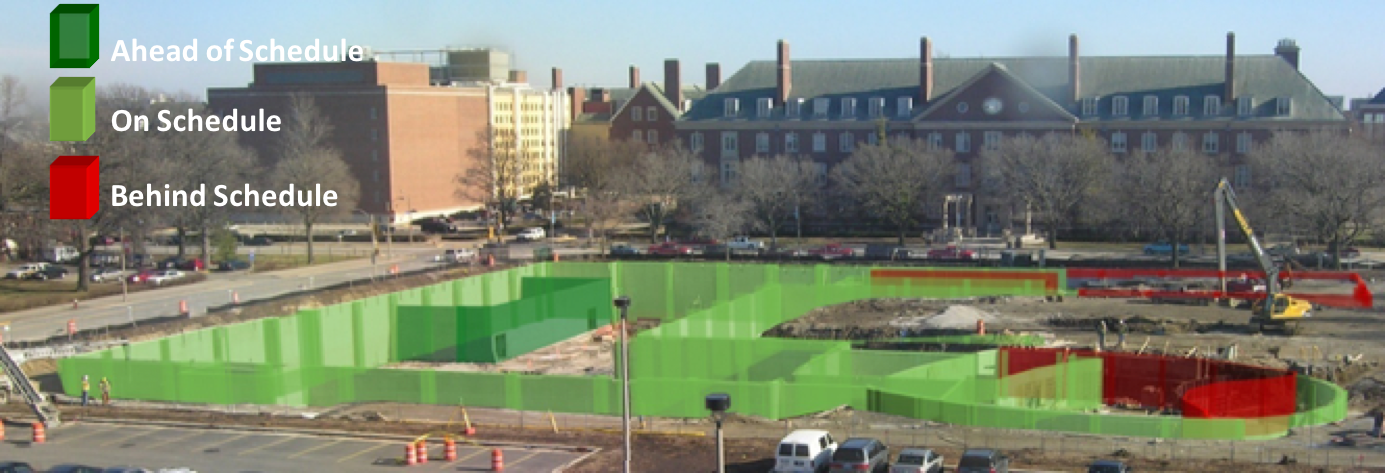What are the benefits of 4D BIM and its integration with reality mapping?
.png)
What are the benefits of integrating 4D BIM and 4D reality mapping?
While 4D BIM is ideal for pre-construction project planning and scheduling practices, it’s not always easy to use effectively for construction coordination. Effective coordination of work sequences during the construction phases requires modeling temporary structures, including scaffolding or the always-changing state of an active construction project.
Modeling these details is vital because many discussions in weekly coordination meetings require an understanding of the site layout, laydown areas, safety, and active areas of construction. This is when modeling the as-built conditions regularly in the form of reality maps and integrating them with 4D BIM is extremely beneficial.
The reality capture process, processing the data, and aligning that against 4D BIM must be simple and efficient enough for field teams to perform regularly. Otherwise, it’s simply too time-consuming to model the ever-changing state of an active construction site. Fortunately, integrations between Reconstruct and Oracle’s suite of construction and engineering software have enabled construction stakeholders to easily create 4D BIM and integrate that against reality data that are captured and processed automatically over the project timeline. With these integrations, all teams can work together to review upcoming work (i.e., “who does what work in which location”), monitor construction progress, understand next steps and installations, mitigate risk, and rapidly detect potential challenges and delays.
This article will zero in on this integration, highlighting the key benefits of creating 4D BIM and integrating that against reality mapping data. Organizations that manage schedule data on other platforms, including Microsoft Project, Asta Powerproject, and Excel, also benefit from similar integrations. Also, organizations that host 2D and 3D design data in other common data environments, such as Autodesk Construction Cloud, Autodesk BIM 360, Procore, and BOX, can also integrate design data and schedules to create 4D BIM. They can also process their reality data using Reconstruct’s reality mapping engine and integrate that against their 4D BIM.
What are the benefits of integrating 4D BIM and 4D reality mapping?
When BIM, reality, and schedule data are brought together, stakeholders have more visibility and control over their projects and schedules than ever before. Here are some of the top benefits of these integrations.
Related: How Reality Mapping Can Fill in the Gaps of 4D BIM.
.png?width=899&height=268&name=Screenshot%20(239).png)
Great planning requires excellent data that is accurate in real-time and visually verifiable. It also requires insights that are actionable.
1. Optimized visual planning and schedule tracking
If you use Oracle Primavera Cloud for master schedules and short-term look-ahead plans (i.e., pull planning tasks), these items can be integrated with BIM models from Oracle Aconex’s common data environment to create and manage 4D BIM in the Reconstruct platform.
By aligning design and schedule data, 4D BIM helps evaluate schedule quality. It also empowers project stakeholders to do better constructability and safety reviews during planning to lock in their schedules before the project starts.
Upon the start of the construction phase, reality capture data can be brought into Reconstruct. Using a unique computer vision-based engine for photogrammetry, 4D reality models are created and integrated with 4D BIM through automated and computer vision processing. Using the resulting 4D digital twins (i.e., the twinning of 4D BIM with 4D reality), the sequence of the upcoming work--who does what work in which location--can be better communicated with the project teams.
Also, progress and productivity can be easily tracked at the work package level, and the risk for delays can be quantified, allowing project teams to proactively adjust their master schedules and look-ahead schedules to keep their projects on time and budget.
What’s more, both remote and on-site stakeholders can better visualize and evaluate construction activities that are scheduled simultaneously to ensure installations are possible, both strategically and safety-wise. The integration also helps teams identify underutilized locations, ensure workflows are correctly optimized, and even validate whether construction steps have been sequenced appropriately.
4D BIM simulation can be easily and quickly created in Reconstruct by integrating project schedules and BIM.
2. Reduced project risk
Integrating Oracle and Reconstruct can also reduce project risk. This is in part because frequent and early alignment between stakeholders leads to swifter risk identification, especially when stakeholders:
- Utilize virtual production models and as-built models.
- Visualize next steps virtually before proceeding with costly and complex installations.
- Proactively update schedules as needed once risks and other concerns are identified and resolved.
This 4D integration also helps stakeholders pinpoint precisely where problems may arise on a reality model, enabling team leaders to address such issues appropriately. In other words, stakeholders don’t just benefit from visually understanding what the completed project looks like, but what the project looks like at present and, most importantly, what upcoming work needs close coordination and communication.
Accompanied by a PowerBI project dashboard that displays locations at risk and the root cause for delay communicated by the project team, project managers and planners have a better understanding of where problems are likely happening and can proactively revise the schedule to address the risk for delay.

A superintendent visually communicates potential project risks shown to project team members via a 4D digital twin during a weekly coordination meeting.
3. Improved communication of the upcoming work sequences
As mentioned above, integrating 4D BIM and 4D reality mapping data enables better communication and construction progress monitoring. This is true both for big-picture visualization and for understanding the minor details of daily tasks.
With the help of Reconstruct and Oracle’s integration, it’s much easier for teams to coordinate what work should occur in what location and who should be performing it. Additionally, this integration allows all teams to fully understand not only the next steps of a project but also to visualize how and where that installation will occur and whether it creates any conflicts. This helps facilitate safe and high-quality installations, reducing the expense and delay of rework.
Moreover, 4D digital twins make the schedule more visible and understandable to more stakeholders. Most people need help to read Critical Path Method (CPM) Gantt charts easily or at all. 4D visualization and reporting make the schedule more widely available to the project team because all project stakeholders can visually see the sequence of construction.
Plus, because stakeholders can review blended 4D reality data and BIM, they can truly visualize how the project's next steps will be affected by lay-down areas, temporary structures, equipment, and the current state of the construction project itself.
And because reality data helps stakeholders anticipate conflicts and clashes that may arise, project teams can perform more intelligent project monitoring, schedule revisions, and, most importantly, expedite approval of payment applications.
4D digital twin, formed by integrating 4D BIM and 4D reality models.
4. Keeping project schedules up to date
4D digital twins make it easier for project stakeholders across all teams to utilize a project schedule and keep it up-to-date. Whether in Oracle or within Reconstruct itself, a detailed schedule can be created, confirmed, managed, and updated as needed.
When imported into Reconstruct, Primavera P6 EPPM or OPC schedules can be used to inspect and report progress, identify root causes of delay, bring stakeholders together to collectively revise look-ahead schedules, ensure all teams are aligned on next steps, and even export the schedule back to Oracle. When needed, excel look-ahead schedules can be created by superintendents and used for progress tracking in Reconstruct. These look-ahead tasks can be easily mapped against master schedule activities, allowing project teams to leverage two types of 4D digital twins: One that shows master schedule, BIM, and reality mapping data together, ideal for owners and owner representatives; and another that shows detailed look-aheads, BIM and reality mapping data, which is ideal for superintendents and project managers for weekly contractor coordination purposes.
What is so unique about the Oracle and Reconstruct integration?
When Oracle Construction & Engineering partnered with Reconstruct, the two companies bi-directionally integrated Oracle's Primavera P6 Enterprise Project Portfolio Management, Oracle Primavera Cloud, and Oracle Aconex with Reconstruct. These integrations on their own allow Oracle P6 and Aconex users to use Reconstruct to create and manage 4D BIM.
Oracle Aconex users can also bring in their reality capture data from various reality capture devices, including smartphones, 360 cameras, drones, and laser scanners, then process them using Reconstruct’s unique photogrammetry engine and use the resulting 4D digital twins to track work in progress and update schedules. When schedules are updated, they can be easily pushed back to Oracle planning environments such that a master record of the schedule is always available to the project schedules and managers.
Reality mapping data can also be pushed back into Aconex so that design vs. reality conflicts can be easily managed for quality assurance/ quality control purposes.
Together, these solutions allow construction stakeholders to visualize their schedule activities at the macro and micro levels. These solutions also allow stakeholders to leverage visually verifiable data and actionable insights to objectively track progress, rapidly simulate construction of next steps, and swiftly manage project changes by always offering transparency on “what’s there” vs. “what should be there.”
About Reconstruct
Reconstruct is a leader in reality mapping and digital-twin-driven project control technology. With key integrations designed to help all stakeholders complete construction safely, on time, and as planned, Reconstruct solutions allow project teams to create 4D BIM and integrate it with 4D reality mapping data to increase visibility, communication, and accuracy on the job site.
To learn more about how integrations with 4D digital twinning and 4D scheduling can help your team fill the gaps of 4D BIM at any phase of construction, contact us or schedule a personalized demo.
Related Posts

How Reality Mapping Can Fill in the Gaps of 4D BIM
4D BIM is great for modeling a structure’s final design. For temporary conditions, fast and intuitive 4D reality mapping fills in the gaps.
.png)
What is 4D BIM? Definition & Benefits
4D BIM integrates “time” with BIM, enabling step-by-step visualization of detailed construction schedules. 4D BIM is also referred to as 4D scheduling.

What AI Can Do for Progress Monitoring
At Reconstruct, our ultimate goal is to fully automate construction progress monitoring so that builders can focus on getting the job done.
